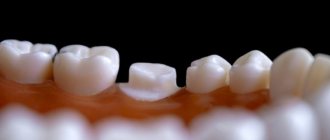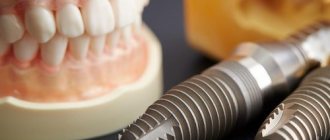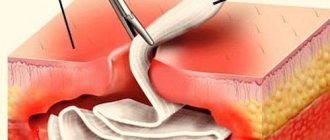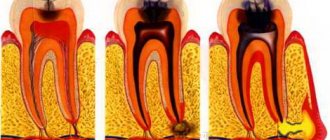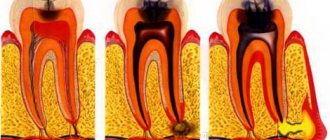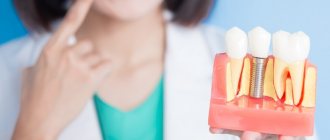What should you do if a small piece of your front, upper, lower or back tooth breaks off? Is it worth resorting to extraction (completely removing the crown) and then installing a prosthesis? Why do strong, hard tissues crack and make your smile unattractive and chewing food painful? In fact, the problem is quite common and can be eliminated in a short time if you consult a dentist in time and do not neglect treatment. In addition, there are preventive measures that, if followed, will help avoid the formation of cracks and chipping.
Reasons for chipping
What causes pieces of teeth to break off (what to do next depends on the provoking factors) most often:
- Traumatic effects on the dentition. This is possible due to a fight, a fall, or an accidental blow.
- Decreased immunity.
- Poor quality installation of orthodontic structures.
- Hormone imbalance. One of the prerequisites is diabetes mellitus and other endocrine diseases.
- Consumption of harmful foods. Caramel candies, nuts, and the simultaneous consumption of hot and cold foods lead to injury.
- Untreated dental pathologies.
- Incorrect positioning of incisors, canines and molars and nocturnal bruxism.
- Damage to caries. This applies to both the initial and later stages.
- Smoking and other bad habits. Alcohol and cigarettes contribute to the thinning of the enamel layer.
- Demineralization, lack of phosphorus, calcium and other essential substances.
- Low acidity in the mouth. An insufficiently balanced diet leads to an imbalance in the acid-base balance.
- Damage to the filling material.
- Presence of cracks on the surface.
- History of chronic diseases.
Pharmacy adhesive for dentures
Nowadays, there are different methods for restoring orthopedic devices. The adhesive is used when the patient wears removable dentures. The quality indicators of pharmaceutical glue are different, but in any case they are lower than those of dental cement. But the structure temporarily holds securely. In order for the special glue to help fix the device, the patient must follow several rules.
- Before fastening, the device must be thoroughly cleaned, food residues and previous cement must be removed.
- After cleaning, the product is washed with a stream of water and then dried. Moisture must be removed, otherwise there will be no good adhesion. Some products do not require drying before application.
- Then an adhesive substance is applied to the prosthesis. The device is then installed in the oral cavity. It is better to apply the glue in small dots, peas or strips.
If the location is perfectly accurate, the product will stick perfectly. The strength will increase when, after installing the device, you squeeze your jaw and hold it in this position for about a minute. It is better to use glue with natural substances, which guarantees patient safety: Corega, Fittident, Protefix, Lakalut, President and others.
If a denture breaks, some people use superglue. However, dentists do not recommend doing this, because it contains industrial ingredients. They have a toxic effect on the body. Despite the fact that the device is firmly fixed, the risk of tissue poisoning is high. Also, superglue should not be used to fill small chips or cracks to prevent new defects from appearing.
When selecting dental glue, the degree of viscosity of the substance and its liquid characteristics should be taken into account. Consistency determines the amount of substance consumed. Liquid mixtures are used during the adaptation period; they provide comfort when worn. Flavored options are not suitable for everyone, as they distort the taste sensation.
Symptoms
Treatment of a small chip on the enamel of a tooth (front or back) should be started as early as possible. If the broken fragment is too small, it may not cause any discomfort, only aesthetic. This does not mean that you should neglect a visit to the doctor, since very soon the problem will grow to much more serious proportions, and therapy will be long and expensive.
Characteristic symptoms:
- visible cracks on the surface;
- loss of filling;
- exposed nerve endings;
- violation of the integrity of the coronal part;
- increased sensitivity to temperature changes;
- pain syndrome, especially at night.
Injury
Single or chronic - the third reason for possible tooth chips
A single injury occurs when there is a blow, an accident, or accidentally biting on a hard object while chewing.
There are three types of chronic injury
- Due to malocclusion (when the teeth do not close correctly, some teeth may receive excessive load, close in the wrong areas, at the wrong angle, or with an opponent that is not their power). For example, a powerful fang of the lower jaw can be positioned in such a way that when closed, it will severely injure the incisor on the upper jaw, which is much inferior to it in size and power. As a result of such long-term closure, the incisor can get into big problems, and the patient will face the need for treatment or removal.
- Due to the absence of other teeth (when a number of teeth are missing, their work is performed by the remaining ones; excessive load may one day result in a fracture of the tooth, a break in its wall, or a split in the root).
- Due to bruxism (“idle” teeth grinding) or other parafunctional manifestations.
How to avoid?
- Be sure to restore missing teeth (there are a lot of ways today, there are even temporary prosthetics if for some reason you need to postpone dental treatment).
- Consult an orthodontist, orthopedist or periodontist about bite problems and undergo orthodontic treatment if indicated.
- Get advice from an orthopedist/gnathologist and psychotherapist about the possible causes of bruxism and take possible measures that the doctor recommends.
Types of damage
There are several types of dental injuries with fractures. The classification sign is the depth and degree of injury.
Enamel chip or microcrack
In this case, the integrity of the upper layer of hard tissue is compromised - it cracks, or a small fragment separates. Usually such problems are invisible and do not cause discomfort. These are minor defects that can be quickly treated, but people do not rush to the dentist with them, which is a serious mistake.
What to do if part of a front tooth or a piece of a back tooth chips or falls out? It is important to visit a dental clinic as soon as possible. Damaged structures will become a place for the spread of pathogenic microflora, which will provoke the development of caries and other diseases. In addition, the load when chewing food will increase significantly, so half of the crown may fall off at any moment.
Chip with dentin fracture
Dentists classify this type of damage as moderate. Symptoms may be pronounced or completely absent. If the dentin layer is not restored, the unit will gradually crumble and soon fall apart. In addition, the smile will become unattractive, especially if a piece of an incisor is missing.
Deep fracture to the pulp tissue with exposure of the nerve
This is a severe injury with serious symptoms such as bleeding and severe pain. Even strong painkillers help dull unbearable sensations only for a short time. The crown may be missing half or more. If you are late with medical intervention, the risk of infection, inflammation and other pathological processes that are difficult to treat increases significantly.
Did part of your tooth break off or decay?
8
or order a free call
Request a call
The patient was extremely satisfied!
Moreover, pay attention, next to it there is a tooth with a metal-ceramic crown and this crown has dark gums. Naturally, we cannot copy dark gums; this is not necessary.
The patient, having seen such a wonderful result, wanted to redo her already old, metal-ceramic crowns on the left and right. That is, the patient was so impressed that we made her new tooth look natural. But that is another story. ))
Author:
Sergey Samsakov
orthopedic dentist
born 02/02/1989
Education:
2011 — Graduated from the Moscow State Medical and Dental University named after. A.I.Evdokimova
2012 — Internship in the specialty “Orthopedic Dentistry”, Moscow State Medical University named after. A.I.Evdokimova
2014 - Residency in Orthopedic Dentistry, Moscow State Medical University named after. A.I.Evdokimova
What to do if a piece of a tooth breaks off
First of all, you need to visit a dentist. Panic is unacceptable, since the situation is fixable, and at the initial stage it is quickly corrected. A specialist should examine the oral cavity and assess the extent of the problem. If the damage is mild or moderate, it is advisable to carry out treatment in the coming days. If the pulp is exposed, you need to urgently go to the doctor on duty. Otherwise, the patient will not be able to eat, rest, or sleep normally due to unbearable pain.
Relieving symptoms at home
To reduce discomfort and relieve pain, it is necessary to organize pre-medical care. The remaining manipulations will be performed by professional doctors after a visit to the dental clinic. Procedure:
- Rinse your mouth with clean running water.
- To reduce swelling, apply a cold compress to the inflamed area. Apply a sterile bandage if bleeding occurs.
- Take painkillers.
If a piece of a tooth breaks off, the nerve hurts, or the root is split, you should not throw away the fragment of tissue; it is better to show it to a doctor. The fragment may be needed for subsequent restoration.
Emergency assistance before visiting the dentist
Immediately after the incident, urgent measures must be taken. All the steps listed above are mandatory: first, splinters and particles of food are removed by rinsing, then cold is applied to the gums to eliminate inflammation and discomfort, and oral analgesics are used.
Additionally, it is recommended to rinse the mouth with a weak antiseptic solution. To do this, you can use chlorhexidine, furatsilin or any other gentle composition.
Treatment by a doctor
There are several ways to repair a chipped tooth (how it is treated depends on the degree of damage and the presence of pain). Therapeutic intervention options:
- Artistic restoration. Special composites are used. Acceptable when breaking off small fragments.
- Installation of veneers and lumineers. Used for cracks, chips and formation of crevices.
- Recover using tabs. This is how a significant piece of bone tissue is reproduced.
- Prosthetics (crowns). Indicated when most of the dental unit is missing.
Did part of your tooth break off or decay?
Always at your service - Sergey Samsakov, orthopedic dentist with more than 10 years of successful experience, Moscow. Expert in 3D digital smile modeling, veneers and CEREC technology.
Patients come to me from all over Russia:
Restorative methods in dentistry
The method of restoration depends simultaneously on several factors: the degree of damage, the results of diagnostic studies, general health, medical history and financial capabilities of the patient. The therapeutic regimen is developed on an individual basis. What to do if a front tooth is chipped and why the back teeth are chipped should only be determined by a doctor; self-diagnosis is ineffective.
Remineralization
Remineralization therapy is the simplest recovery option for minor chips. The technique is used for microcracks and other small defects, as well as for preventive purposes to prevent such problems. A special solution with nutrients is applied to the surface, and as a result, the protective properties of the enamel are restored.
Fluoridation
Damaged and healthy teeth are covered with medicinal solutions, gels or varnishes with a large amount of fluoride. Treatment is carried out in stages. This is one of the effective ways to completely restore a chipped front tooth. This method is only beneficial for minor injuries.
Building up
Indicated for moderate injuries. A paste-like mass is applied to the surface in layers, each layer is fixed. The doctor must carefully select materials of the desired shade and texture so that the restored areas remain invisible and do not stand out from the rest.
This method is highly effective and attractively priced. The first thought that arises in most patients when asked what to do if a back tooth is chipped (chipped front teeth are rarely eliminated in this way) is to build up the missing fragment. The technique is in great demand.
Filling and microprosthetics
They are indicated for extensive damage to bone tissue and internal sensitive layers. The doctor carefully examines the results of diagnostic studies (including panoramic and spot images), listens to the patient’s complaints and advises which method is best to use. Restoration is possible using conventional fillings, inlays, veneers, and lumineers. What to do if a back tooth breaks off (the reasons do not matter) and is completely lost? In such a situation, prosthetics using implants or installation of artificial crowns is performed.
The amount that the patient sees in the final settlement after the intervention may be unpleasantly surprising. Before you ignore a small crack in the enamel and neglect a visit to the dentist, it is better to think about possible upcoming expenses.
Features of artistic restoration using composites
First of all, the patient is promptly restored to the shape of the tooth using “available” materials in order to maintain the aesthetics of the smile area during treatment. The level of today's dental materials is so high that some patients are completely satisfied with such restoration and refuse further cooperation. Therefore, for not the most motivated clients, temporary modeling is performed without achieving complete color similarity.
Then a silicone impression is taken from the damaged and temporarily restored tooth, on the basis of which a so-called key will be made, which will allow the artistic part of the work to be completed with high quality.
To achieve an ideal resemblance, the dentist, even with a small chip, has to combine from 3-4 to 5-6 shades of the photopolymer composite. If you do this at random, the patient will not be very pleased with the result: the restored part will differ from natural tissue. The key helps to accurately maintain the relationship between all layers of material of different tones, so that the saturation, lightness and transparency of the restored and natural parts completely coincide.
Special cases
Some injuries require a specific approach, which has its own characteristics against the backdrop of generally established rules. We should look at them in more detail.
Wisdom tooth
"Eights" cannot be restored. The fact is that this makes no sense, because they are not involved in the process of chewing food and are not so important for the functioning of the maxillofacial apparatus. Doctors resort to extraction; subsequent prosthetics are not performed.
Unit
Such damage is the most aesthetically unattractive, because it is visible to others if a person smiles or simply talks. Treatment methods can be any, it all depends on the dentist’s recommendations and the patient’s personal preferences and financial capabilities.
Most often, artistic restoration is used. The specialist selects the composition of the required shade and applies it to the surface. The layer of material is fixed with a special device with light radiation.
What to do if half a tooth breaks off, how will it be treated (a significant fragment has broken off along with dentin)? In this case, veneers are used. This is a reliable method that is durable. Over time, the color of the enamel does not change and remains attractive.
For the most serious damage, crowns made of ceramics, metal-ceramics, and zirconium oxide are installed. The final cost of therapy depends on the choice.
Lateral teeth
They are treated in the same way as the front ones. However, since others cannot see from the outside that there is anything wrong with your smile, ordinary fillings will do. The best option is extension. Overlays are not installed in this case.
If the nerve is damaged, the wound is first treated with an antiseptic. Then depulpation or extraction is carried out followed by prosthetics.
Dairy elements
What to do with a chipped tooth and how to treat it if it hurts? Many parents mistakenly believe that there is no need to correct problems that arise with children’s first incisors, canines and molars - they will fall out sooner or later anyway. This is a big misconception, because the doctor is able to quickly stop further cracking with a filling or a special gel without pain or other unpleasant sensations.
Children are often injured due to falls during active play. If you ignore the treatment of chips, this often leads to stomatitis and increased sensitivity of the dentition.
Procedure:
- calm the baby;
- give him clean water to rinse his mouth;
- disinfect soft tissues if they are damaged;
- save the fragment for the dentist.
No more than 24 hours should pass from the moment of injury to the visit to the dentist. Most likely, the child will be sent for an X-ray. The condition of the permanent one depends on the health of the primary occlusion.
Vertical crack
What should you do if your front tooth chips a little, but the absence of fragments is not visible, only a crack running from top to bottom is noticeable? At first glance, this problem seems insignificant. However, this opinion is erroneous, because most often the pulp is involved. In this case, the enamel layer cannot be restored.
If at first only a small strip is visible on the surface, over time, under constant pressure, it develops into large chips. Timely consultation with a doctor guarantees quick and easy restoration of the dental unit. Otherwise, you cannot do without installing crowns or veneers.
Occurrence of a vertical crack
Sometimes a chip does not appear, but the tooth cracks vertically - this is very noticeable from the outside. The choice of treatment method will be based on how severely the enamel is damaged and how deep the crack goes.
There are three main treatment options:
- Standard filling.
- Installation of external onlays on the tooth.
- Removal and subsequent implantation.
It is important to resolve the problem quickly before numerous potential complications arise.
Complications after chipping
Restoring a chipped front tooth or a chipped molar (what to do in the case of different types of damage is discussed above) should be mandatory. Firstly, the aesthetic component suffers. A smile looks ugly, a person develops complexes, he is always afraid that others will notice the defect. Secondly, if you neglect medical intervention, you cannot avoid negative consequences (sometimes irreversible). These are problems such as:
- malocclusion;
- curvature of roots;
- increased sensitivity to external stimuli (cold, hot, sour, sweet);
- pulpitis, periodontitis and other diseases.
All of these conditions are considered very serious. Most of them often lead to the loss of units and affect the health of neighboring elements.
Oral diseases affect other organs. For example, if a large piece of a back tooth breaks off and the remaining fragment or the entire row hurts, this can later be associated with diseases of the gastrointestinal tract, heart and blood vessels, and urinary system. Even microcracks can lead to such complications. Thus, unpleasant consequences can only be avoided with the help of timely intervention by a dentist.
How to glue dentures at home
In addition to the fixing device for dentures presented above, there are also quite high-quality compositions. They can be used to secure removable dental bridges or dentures. They are also used for temporary fixation, and the duration of its effect is 1 day. You can purchase the products at any pharmacy, and the average price will be 90-120 rubles.
As for preparations such as glue and gels for gluing dental crowns, they can be used to fix a bridge that has broken. In addition, the effect of such a cream is that it freshens breath and protects the soft tissues of the mouth from rubbing with ceramic, metal and plastic structures.
Prevention
To prevent chipping of hard tissues, you must adhere to the following rules:
- do not neglect daily cleaning and other hygiene procedures;
- visit the dental clinic every six months for preventive examinations;
- promptly treat caries and other diseases;
- adhere to a proper balanced diet;
- lead a healthy lifestyle, eliminate bad habits;
- if the bite is broken, take measures to correct it;
- minimize the risks of traumatic effects (too hard food is one of the main reasons why a piece of a back tooth breaks off, an incisor or a fang breaks off);
- periodically resort to professional cleaning to remove plaque and stone;
- consult a doctor even if microcracks appear that are not accompanied by unpleasant symptoms.
The dentition is a vulnerable place, especially if you neglect hygiene rules, often chew caramel, smoke, ignore oral diseases and make other mistakes. Chips of the enamel and deeper tissues often lead to serious complications if restoration is not started in time. Before determining what to do if a piece falls off or half of a tooth breaks off, the doctor must determine the extent of the damage and decide whether it is possible to restore the dental unit without resorting to the last resort - extraction.
Recommendations from experts
It is impossible to completely exclude the possibility of the formation of dental defects, but in order to minimize the risk of cracks and chips in the teeth, experts recommend following a few simple rules that will help strengthen tooth enamel and make it more resistant to mechanical damage:
- Pay close attention to your oral hygiene, don’t be lazy about brushing your teeth twice a day, and don’t shy away from using dental floss and mouthwash.
- If possible, limit yourself to consuming sugary edibles. Of course, many people love cakes, sweets and ice cream, but everything should be in moderation!
- Include in your daily diet foods rich in fluoride, calcium, phosphorus and vitamin C: natural milk, sour cream, kefir, fermented baked milk, cottage cheese, various types of cheeses, herbs and nuts.
- Visiting the dentist at least twice a year, a timely scheduled examination makes it possible to identify most oral diseases at an early stage.
Where to buy and how much does special adhesive for dentures cost?
For each material, it is recommended to use a special adhesive for restoring broken crowns. Self-hardening plastic Protakryl-M (powder, liquid) is used. Its cost is significant - up to 900 rubles, but the substance is used for rapid polymerization, creation and repair of prosthetic bases. The determining criterion for selection will be the hypoallergenic properties of the composition. The following products are available for free sale and are available to all categories of patients:
- Protefix is a budget option for quickly gluing artificial teeth together. This affordable composition is used for all types of crowns and eliminates side effects and contraindications. The price of the drug is from 120 rubles.
- Corega is a more expensive product that can also glue a cracked crown together for a short period of time. The drug is an “emergency aid” to reach the specialist in a timely manner with a request for correction. Cost – from 150 rub.
- ROCS is a European adhesive for fixing dentures, which patients buy if a crown unexpectedly breaks and there is no extra money for restoration. Price – from 250 rub.
When to use crowns
If the destruction is significant, the dentist will suggest installing a veneer or crown.
Crowns are made from:
- Porcelain or composite resins are the most natural-looking materials;
- Metal – these crowns are the strongest.
If the coronal part is destroyed and the root remains intact, the patient will have a pin installed and covered with a crown.
To install a crown, two visits to the doctor are required:
- At the first appointment, an x-ray is taken, the teeth are ground, an impression is made, and a temporary crown is placed;
- At the second visit, the patient receives a permanent crown.
Before deciding on treatment for an injured tooth, the doctor orders an x-ray to understand the condition of the root. Not in all cases it is possible to save the tooth.
Indications for tooth extraction
- The remains of the root part are too fragile to be used as a basis for restoration;
- There is caries damage;
- The chip goes into the deep root part;
- The root is unstable;
- Atypical tooth location;
- The remaining part of the tooth is loose.
In case of removal, the issue of implantation is considered - instant or performed using the classical technique.
When using instant implantation, bone tissue is not built up - an artificial root is implanted immediately after tooth extraction. The main condition is a healthy jaw. If there are contraindications for using this option, a procedure for increasing the volume of bone tissue and introducing an implant in the classical way can be performed. Before the choice of method is made, the dentist conducts an examination and identifies the patient’s characteristics. If necessary, an orthodontist or other specialist is consulted if problems are identified.
How to put on Perfect Smile pads correctly?
Having purchased a new product, first of all you need to read the instructions on how to install Perfect Smile veneers. It is extremely important to follow clear instructions to avoid improper placement of the overlays on your teeth and gums, as well as any discomfort.
Instructions for use of Perfect Smile Veneers:
- Preparation - place the plates in a glass of hot water for several minutes until the white coating becomes transparent;
- Shaping - we firmly press the veneers to the natural teeth to obtain the required outline of the plate;
- Hardening - immerse the veneers in cold water for a few minutes until the white coating reappears;
- Installation - we put on the plates like ordinary plug-in elements.
The versatility of Perfect Smile Veneers lies in the ability to shape the onlays identical to natural teeth.
Only with proper preparation will Perfect Smile veneers last a long time, will not cause inconvenience and wear well: they do not fall out and do not interfere with talking or eating.
Many buyers complain about the poor quality of the product, not knowing how to use veneers correctly. Therefore, we recommend watching a video on how to put on Perfect Smile Veneers:
https://www.youtube.com/watch?v=1XxFwsLk1Cc
The importance of following recommendations for installation and operation of overlays is sometimes underestimated. The quality of your future smile depends on the correct preparation and placement of the plates. Placing veneers according to the rules allows you to avoid possible difficulties and save time before an important event.
Instructions for use
In addition to the installation instructions, it is necessary to take into account the manufacturer's instructions for using the Perfect Smile Veneers design. It is important to store the product correctly and promptly clean it from food residues.
Basic rules when using Perfect Smile Veneers:
- The pads must be stored in a special container included with the product;
- The plates should be washed regularly for cleaning and disinfection;
- It is better to soften the veneers and give them shape immediately before installation;
- It is not recommended to attempt to use the pads for purposes other than their intended purpose;
- The plates must not be broken, bent or subjected to other traumatic effects.
When used correctly, Perfect Smile Veneers can last for many years and will not require immediate replacement.
You can wear veneers throughout the day, but at night it is recommended to remove them and wash them.
The product should be washed according to the manufacturer's instructions:
- Perfect Smile Veneers can only be washed in warm water;
- It is not recommended to use soap substances intended for hair and body;
- You should not use devices with solid particles, for example, scrubs, toothbrushes, especially with hard bristles;
- Avoid using chemicals;
- It is better to rinse the plates under running water;
- The product should dry naturally.
The best way to clean veneers is to use warm water and baking soda; you can also use toothpaste or powder, but apply them with your finger. After the procedure, the plates should be lightly blotted with a towel and left to dry in a well-ventilated area.

